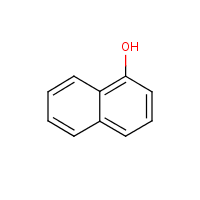1-Naphthol
Agent Name
1-Naphthol
Alternative Name
alpha-Naphthol
CAS Number
90-15-3
Formula
C10-H8-O
Major Category
Other Classes

Synonyms
alpha-Naphthol; 1-Hydroxynaphthalene; 1-Naphthalenol; BASF Ursol ERN; C.I. 76605; C.I. Oxidation Base 33; CI 76605; CI Oxidation Base 33; Durafur Developer D; Fouramine ERN; Fourrine 99; Fourrine ERN; Furro ER; Nako TRB; Tertral ERN; Ursol ERN; Zoba ERN; alpha-Hydroxynaphthalene; alpha-Naphthol; [ChemIDplus] UN2811
Category
Naphthols
Description
Colorless or yellow solid; [Hawley] Darkens on exposure to light; [Merck Index] Colorless crystalline solid; [MSDSonline]
Sources/Uses
Used to make dyes, intermediates, synthetic perfumes, agrochemicals, drugs, and rubber antioxidants; [HSDB] Used in organic synthesis; [Hawley] Used in photography; in the hide tanning process; in pyrotechnics for black smoke; [IUCLID]
Comments
Toxic by ingestion or skin absorption; [Hawley] A skin and respiratory tract irritant; May cause severe damage to eyes; [eChemPortal: ESIS] An irritant; A severe eye irritant which may cause serious injury; May be absorbed through skin; May cause kidney injury; Effects in high-dose animal studies include impaired liver function tests and CNS injury; [MSDSonline] May cause skin irritation and eye injury; [Ullmann] Toxic by ingestion; Alpha isomer is more toxic than beta isomer; Lethal human dose = 50-500 mg/kg (beta-Naphthol); Acute effects include liver and kidney injury, hemolytic anemia, and lens opacities; [HSDB]
Biomedical References
Exposure Assessment
Vapor Pressure
0.000274 mm Hg
Lethal Concentration
LC50 (rat) > 420 mg/m3/1h
Explanatory Notes
The Guide in the Emergency Response Guidebook is for "Toxic solid, organic, n.o.s."
Adverse Effects
Anemia
Hemolytic anemia
Hepatotoxin
Hepatoxic (a) from occupational exposure (secondary effect) or (b) in animal studies or in humans after ingestion
Nephrotoxin
Yes
Diseases, Processes, and Activities Linked to This Agent
Processes
Industrial Processes with risk of exposure: